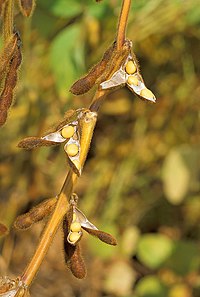
Photo from wikipedia
It has been shown that 15 μW·cm-2 UV-B radiation has the most pronounced effects on γ-aminobutiric acid (GABA), inositol 1,4,5-trisphosphate (IP3) and abscisic acid (ABA) accumulation in 4-day-old soybean sprouts. Nevertheless,… Click to show full abstract
It has been shown that 15 μW·cm-2 UV-B radiation has the most pronounced effects on γ-aminobutiric acid (GABA), inositol 1,4,5-trisphosphate (IP3) and abscisic acid (ABA) accumulation in 4-day-old soybean sprouts. Nevertheless, its mechanism of action, from the perspective of protein expression, remains largely unknown. In this study, isobaric tags for relative and absolute quantitation (iTRAQ) were employed to investigate UV-B treatment-induced proteomic changes in soybean sprouts. Results showed that UV-B treatment effectively regulated proteins involved in GABA biosynthesis, such as glutamate synthase, glutamate decarboxylase (GAD), methionine synthetase, 5-methyltetrahydropteroyltriglutamate--homocysteine methyltransferase, aminoaldehyde dehydrogenase (AMADH) and inositol phosphate metabolism pathways, including phosphoinositide phospholipase C (PI-PLC), purple acid phosphatase (PAP) and inositol polyphosphate 5-phosphatase. In addition, proteins involved in ABA biosynthesis and signal transduction, such as 9-cis-epoxycarotenoid dioxygenase (NCED), abscisic-aldehyde oxidase (AO), SNF1-related protein kinase (SnRK), protein phosphatase 2C (PP2C), guanine nucleotide-binding protein and calreticulin-3, were also modulated under UV-B treatment.
Journal Title: Food chemistry
Year Published: 2019
Link to full text (if available)
Share on Social Media: Sign Up to like & get
recommendations!